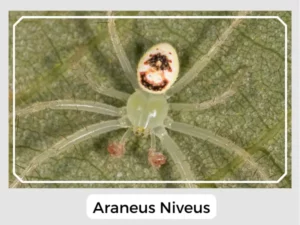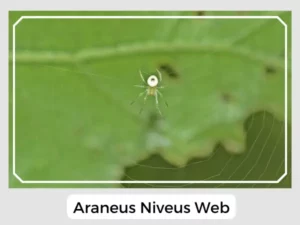Araneus niveus, often seen in North America, belongs to the fascinating family of orb weaver spiders. These spiders are known for their impressive webs. Get ready to discover interesting facts about them right here!

Photo Credit: Mark Etheridge
Females lay their eggs inside a silk sac.
They emerge from the sac, undergoing several molts until they reach adulthood.
The webs of Araneus niveus are circular, serving as effective traps for their insect prey and as a testament to the spiders’ engineering skills. These structures are not only homes but also strategic hunting grounds for the spiders.

Photo Credit: Barb Sendelbach
Yes, Araneus niveus spiders are venomous, like most orb weavers, but their venom is generally not harmful to humans.
While Araneus niveus spiders can bite if threatened or provoked, bites are rare and usually result in mild discomfort, similar to a bee sting.
Araneus niveus spiders play a vital role in their environments. Their predation helps manage insect populations, which could otherwise grow to pest-like numbers, affecting both human activities and the health of ecosystems. Their behavior patterns, such as nocturnal hunting and seasonal web construction, are closely aligned with the rhythms of nature.
Natural Predators: In the food chain, these spiders are also prey. Birds, small mammals, and larger insects are common threats to Araneus niveus, making their survival a delicate balance of predator and prey dynamics.
Prey-Predator Dynamics: Their diet mainly consists of insects that become ensnared in their intricately woven webs. The impact of Araneus niveus on the insect populations illustrates the complex interactions within food webs and the importance of each species in maintaining ecological equilibrium.
Relationship with Humans: Humans and Araneus niveus spiders maintain a largely beneficial relationship. These spiders are unobtrusive and provide natural pest control. Their presence in agricultural areas, such as orchards, can be particularly advantageous in managing insect populations that might otherwise damage crops.
| Lifespan | Around 1 year |
| Distribution | North America, primarily in the United States |
| Habitat | Coastal areas, forests, and orchards |
| Diet | Insects |
In conclusion, the Araneus niveus spider is a small yet significant component of North American ecosystems.
Araneus niveus, often seen in North America, belongs to the fascinating family of orb weaver spiders. These spiders are known for their impressive webs. Get ready to discover interesting facts about them right here!

Photo Credit: Mark Etheridge
Females lay their eggs inside a silk sac.
They emerge from the sac, undergoing several molts until they reach adulthood.
The webs of Araneus niveus are circular, serving as effective traps for their insect prey and as a testament to the spiders’ engineering skills. These structures are not only homes but also strategic hunting grounds for the spiders.

Photo Credit: Barb Sendelbach
Yes, Araneus niveus spiders are venomous, like most orb weavers, but their venom is generally not harmful to humans.
While Araneus niveus spiders can bite if threatened or provoked, bites are rare and usually result in mild discomfort, similar to a bee sting.
Araneus niveus spiders play a vital role in their environments. Their predation helps manage insect populations, which could otherwise grow to pest-like numbers, affecting both human activities and the health of ecosystems. Their behavior patterns, such as nocturnal hunting and seasonal web construction, are closely aligned with the rhythms of nature.
Natural Predators: In the food chain, these spiders are also prey. Birds, small mammals, and larger insects are common threats to Araneus niveus, making their survival a delicate balance of predator and prey dynamics.
Prey-Predator Dynamics: Their diet mainly consists of insects that become ensnared in their intricately woven webs. The impact of Araneus niveus on the insect populations illustrates the complex interactions within food webs and the importance of each species in maintaining ecological equilibrium.
Relationship with Humans: Humans and Araneus niveus spiders maintain a largely beneficial relationship. These spiders are unobtrusive and provide natural pest control. Their presence in agricultural areas, such as orchards, can be particularly advantageous in managing insect populations that might otherwise damage crops.
| Lifespan | Around 1 year |
| Distribution | North America, primarily in the United States |
| Habitat | Coastal areas, forests, and orchards |
| Diet | Insects |
In conclusion, the Araneus niveus spider is a small yet significant component of North American ecosystems.